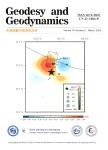Simulation of coseismic effects of the Ms7. 0 Lushan earthquake
Simulation of coseismic effects of the Ms7. 0 Lushan earthquake作者机构:Key Laboratory of Earthquake GeodesyInstitute of SeismologyChina Earthuake Administration Wuhan Bace of Institute of Crustal DynamicsChina Earthquake Administration
出 版 物:《Geodesy and Geodynamics》 (大地测量与地球动力学(英文版))
年 卷 期:2013年第4卷第3期
页 面:12-18页
学科分类:070801[理学-固体地球物理学] 07[理学] 0708[理学-地球物理学]
基 金:supported by the National Natural Science Foundation of China(41104049) the Seismic Industry Research Project(201008001) the Earthquake Tracking Task of China Earthquake Administration(2013020211)
主 题:Lushan earthquake dislocation theory coseismic effects simulation
摘 要:Using plane dislocation theory and the seismic-wave inversion results from the Institute of Geophysics, China Earthquake Administration and the Institute of Geodesy and Geophysics, Chinese Academy of Sciences models, the surface coseismic deformation and gravity changes caused by the 2013 Ms7.0 Lushan earthquake are simulated. The simulations of coseismic gravity change and deformation indicate that the dislocation has dip-slip characteristics. The results also show that the coseismic deformation exhibits a symmetrical, positive-and-negative distribution, with the deformation usually being less than 10 mm in the far- field but up to 140 mm in the near-field. The gravity changes are concentrated on the fault-projection area, which is greatly affected by the vertical surface deformation. The gravity change and vertical deformation in the far field are usually less than and 5 mm, respectively, but reach and 330 mm, respectively, in the near field. The simulated results agree well with the measured resuhs, which suggests a theoretical basis for the observed change in gravity before and after this earthquake.



